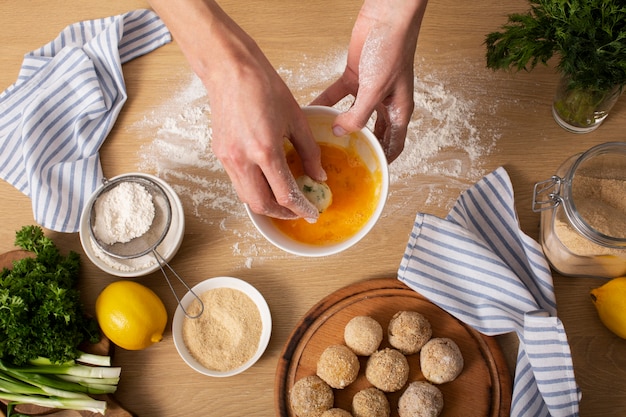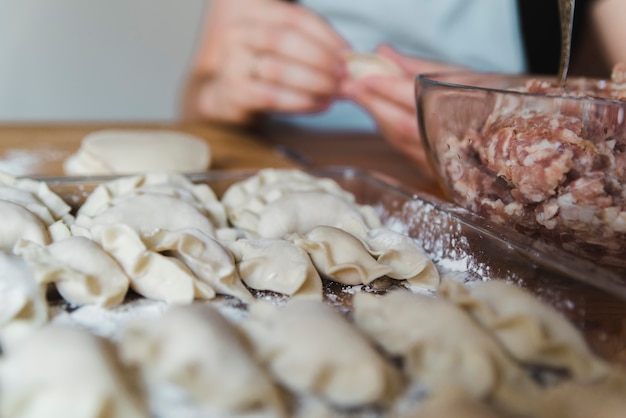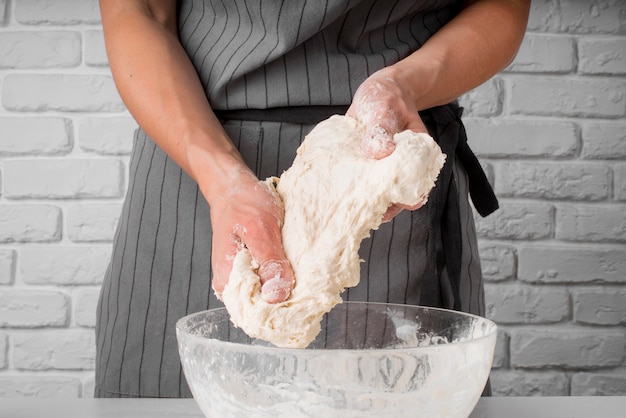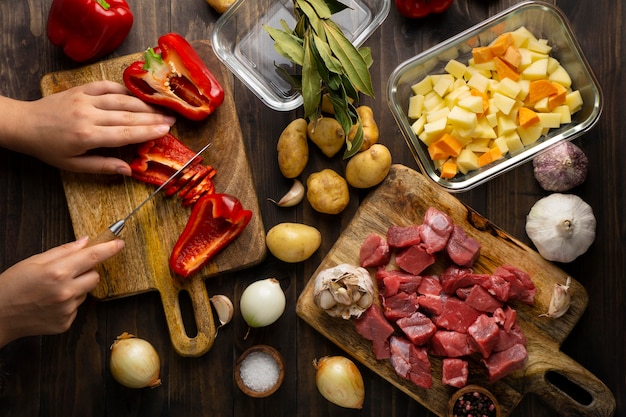You’ve got a bag of fresh ravioli in the fridge, and you're excited to whip up a delicious meal. But the question lingers - how long do you actually cook them? I've been there, staring at the pasta, wondering if it'll turn into mush if I leave it in the water for too long. It's a real concern! Over time, I've picked up a few tips and tricks for cooking fresh ravioli perfectly. Let's dive into the perfect timing guide, because, let's face it, we all want to avoid that dreaded mushy pasta experience, right?
Part 1: The Basics of Fresh Ravioli

Before we even talk about timings, let's understand what makes fresh ravioli different from the dried stuff you find in the supermarket. Fresh ravioli is all about those delicate, thin pasta sheets, made with simple ingredients: flour, eggs, and sometimes a touch of salt. This creates a texture that's delightfully chewy and melts in your mouth. But it also means it needs a slightly different approach when it comes to cooking.
The Importance of Freshness
The freshness of your ravioli is critical. If it's been hanging out in the fridge for a while, the pasta sheets might start to dry out, making them a little tougher. Not a major problem, just a small adjustment to the cooking time is all you need. But if you've just picked it up from the shop, then you're in for a real treat! The pasta will cook up beautifully, soft but not mushy, just as it should be.
Part 2: Choosing the Right Pot

Now, let's talk about the pot. You wouldn't try to cook a massive roast chicken in a tiny pan, would you? Same goes for ravioli! You need enough space for the pasta to move around and cook evenly. I usually use a large, deep pot. The water should be able to cover the ravioli completely, with an inch or two to spare. This ensures they cook evenly and don't stick together. It's all about that lovely, even cooking!
The Importance of a Large Pot
You might think, "Oh, I'll just cram them in, it'll be fine." But it won't, trust me. Crowded ravioli means uneven cooking. Some will be mushy while others are still raw. Avoid the disappointment, use a big pot!
Part 3: Boiling the Water

Your water needs to be a raging torrent, absolutely boiling. This is the secret to perfect ravioli. The rapid heat ensures that the pasta cooks quickly and evenly, preserving that lovely fresh texture. If the water isn't boiling, you're in for a longer cook time and a risk of overcooked ravioli. So, crank up the heat and wait for those bubbles to come to the party!
The Importance of the "Boiling Point"
Don't just think, "Oh, it's hot enough". No! It has to be boiling. You can test it with a spoon. If the water is boiling, the bubbles will be big and vigorous, and they'll be pulling the spoon around. That's the kind of energy we want for our ravioli. Remember, a good boil is essential for that perfect al dente texture.
Part 4: Adding the Ravioli to the Pot
Alright, the water is boiling away, you're ready to get those ravioli in the pot. But wait! Don't just dump them in all at once. Remember, we want even cooking! I find it works best to add the ravioli in small batches, letting them settle in the water for a minute or two before adding more. This ensures they don't stick together and cook evenly.
The Importance of Gradual Addition
This might seem like a lot of fuss, but it really does make a difference. Trust me, you'll be glad you did! Those ravioli will cook up perfectly, with a lovely texture and a satisfying bite. And we all want that, right? This little extra effort pays off big time, resulting in a beautifully cooked dish.
Part 5: Cooking Time
Now, we're getting to the heart of the matter: how long to cook those fresh ravioli. This is where things get a little tricky because it depends on a few things, like the thickness of the pasta sheets and how fresh they are. But here's a general guideline:
General Cooking Time
Fresh ravioli will usually cook in about 2-3 minutes. You'll know they're ready when they float to the surface. But here's the thing: you don't want to overcook them. I find that 2 minutes is usually enough. You want them to be al dente, which means they're cooked through but still have a bit of bite. If you're not sure, just take one out and try it. If it's still too hard, give it another minute or two.
Part 6: Checking the Ravioli
You've got the boiling water, you've added the ravioli, you've got your timer set, but now comes the important part: checking your ravioli. Don't just assume it's done after 2 minutes. You need to look for signs. Look for these clues:
- They float to the surface: The ravioli are done when they float to the top of the water. This means they've absorbed enough water and are cooked through.
- They look plump: The ravioli will become plump and full as they cook. This is a good sign they're ready to be enjoyed.
- They're tender but not mushy: The ravioli should be tender but still have a slight bite. If they're too soft, they're overcooked.
Don't be afraid to take one out and give it a try! This is how you really know if they're ready. Remember, al dente is the key to perfect ravioli.
Part 7: Draining the Ravioli
Once those ravioli are ready, it's time to drain them. Use a large colander and scoop the ravioli out of the pot. Don't just dump them in, you might end up with a pasta pancake! I like to gently transfer them to the colander with a slotted spoon. This ensures they don't get squished and lose their shape.
The Importance of Gentle Draining
Don't be rough! You've worked hard to cook them perfectly, so be gentle as you drain them. We don't want to ruin all that effort. This is the crucial step for preserving that delicate texture. Think of it as a final act of care for your delicious ravioli.
Part 8: Serving the Ravioli
Now, this is the part you've been waiting for! Your ravioli is cooked, it's drained, and it's ready to be dressed up and served. You can go for a classic tomato sauce, a creamy pesto, a rich meat ragu – the possibilities are endless!
The key is to use a sauce that complements the ravioli. You don't want to overwhelm the delicate flavour of the pasta with something too heavy or strong. I find that simple sauces really let the ravioli shine. A simple sauce allows the flavour of the ravioli to be the star of the show.
Tips for Serving Ravioli
Here are a few tips to make your ravioli presentation even better:
- Toss the ravioli in the sauce gently, just enough to coat them. You don't want to break them up.
- Serve immediately. Ravioli is best served fresh, so don't let it sit around for too long.
- Garnish with a sprinkle of Parmesan cheese, fresh herbs, or a drizzle of olive oil. These finishing touches will really elevate your dish.
Enjoy your delicious, perfectly cooked fresh ravioli! You deserve it!
Part 9: Alternative Cooking Methods
Now, you might be wondering, "Can I cook ravioli in other ways?" The answer is a resounding YES! While boiling is the most common method, here are some other options:
1. Pan-frying
This is a great way to get a crispy texture on your ravioli. Heat some oil in a pan over medium heat. Add the ravioli and cook for about 2 minutes per side, until golden brown. Serve with your favorite sauce. This is a delicious way to cook ravioli if you want a little bit of a crispy texture. The crispy edges add a lovely textural element to the dish.
2. Baking
Yes, you can even bake ravioli! Preheat your oven to 375°F (190°C). Place the ravioli in a baking dish, cover with sauce, and bake for about 15 minutes, or until heated through and bubbly. This is a great option if you're making a large batch of ravioli or if you want a more hands-off approach. This method is perfect for a large family or when you're looking for a less involved cooking process.
3. Steaming
For a lighter option, you can steam your ravioli. Place the ravioli in a steamer basket over boiling water and steam for about 3-4 minutes, or until cooked through. This is a good choice if you're trying to watch your calorie intake. Steaming allows the ravioli to retain its natural flavour and lightness.
Part 10: Common Mistakes and How to Fix Them
We all make mistakes, even seasoned cooks. But it's always better to be prepared! Here are some common mistakes you might encounter when cooking fresh ravioli, and how to fix them:
1. Overcooked Ravioli
This is probably the most common mistake. Overcooked ravioli will be mushy and lack texture. To prevent this, stick to the recommended cooking time and check them frequently. If they're already overcooked, there's not much you can do, but you can try to salvage them by tossing them in a sauce that has a strong flavor, which can mask the overcooked taste. The sauce will add a burst of flavour and help to hide the overcooked texture.
2. Undercooked Ravioli
This is less common, but it can happen. Undercooked ravioli will be firm and raw. If you find this, simply return them to the boiling water for a few more minutes until cooked through. Just don't overcook them! It's important to remember that fresh ravioli cooks quickly, so keep an eye on it.
3. Ravioli Stick Together
This happens when you crowd the pot, and they don't have enough space to cook evenly. To prevent this, add them in small batches and stir them gently. If they've already stuck together, you can try to separate them gently with a spoon. Give them a little space to breathe and they'll cook up beautifully.
FAQs
Let's answer some frequently asked questions about cooking fresh ravioli:
1. Can I cook frozen fresh ravioli?
Yes, you can. Simply cook frozen ravioli for a few minutes longer than fresh ravioli. I usually add about 2-3 minutes to the cooking time. But make sure to check them frequently to make sure they don't overcook. Frozen ravioli will take a bit longer to cook through, so adjust the cooking time accordingly.
2. How can I tell if my ravioli are fresh?
Fresh ravioli will have a slightly moist and springy texture. They should not be dry or brittle. The pasta sheets should be smooth and uniform, with no cracks or tears. If you notice any signs of dryness or cracking, the ravioli might be a little older and could require a longer cooking time. A quick visual check will tell you if your ravioli is ready for the pot.
3. What are some good sauces for fresh ravioli?
The best sauce for ravioli is really up to you! I love simple sauces like tomato sauce, pesto, or butter and sage. But you can also get creative with more elaborate sauces, like creamy mushroom sauce, or even a light meat sauce. The possibilities are endless! Let your taste buds be your guide when choosing the perfect sauce.
4. What can I do with leftover ravioli?
Don't throw out those leftover ravioli! They're great in salads, soups, and even as a filling for a baked pasta dish. You can also freeze them for later. Simply wrap them tightly in plastic wrap or aluminum foil and store them in the freezer for up to 3 months. Get creative with your leftovers! They can be incorporated into a variety of dishes.
5. Can I cook fresh ravioli in the microwave?
It's not recommended to cook fresh ravioli in the microwave. The pasta sheets will likely become soggy and the filling might not heat up evenly. It's best to stick to the traditional methods of boiling, pan-frying, or baking. The microwave is not the ideal cooking method for fresh ravioli. Stick to the tried and true methods for the best results.
I hope this guide has given you the confidence to cook perfect fresh ravioli. Remember, it's all about those delicious little details. So go forth, cook your ravioli, and enjoy a delicious, homemade meal!
Everyone is watching

Perfect Rice Every Time: The Ultimate Guide to Cooking Rice
Cooking TipsAs a self-proclaimed foodie, I've always been a bit obsessed with rice. It's the foundation of countless cuisi...

Ultimate Guide to Cooking the Perfect Thanksgiving Turkey
Cooking TipsThanksgiving. Just the word conjures up images of overflowing tables laden with delicious food, the scent of r...

The Ultimate Guide to Cooking Asparagus: Tips, Techniques, and Recipes
Cooking TipsAsparagus. The mere mention of this spring delicacy conjures up images of vibrant green spears, crisp and burs...

Can You Cook Spaghetti with Gasoline? (The Shocking Truth)
Cooking TipsWe've all seen those crazy internet trends. You know, the ones that make you wonder, "Did someone actually try...

Chorizo and Eggs Recipe: The Ultimate Guide
Cooking TipsRight, let’s talk about chorizo and eggs. You know, that classic Spanish dish that's always a winner. It's th...
